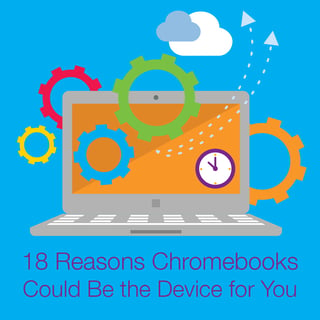Tablets and Smartphones and Laptops – Oh, My!
 There are so many devices to choose from for your classrooms. Sometimes it is really hard to know what makes one a better choice than others. And by “better,” I mean a better fit for your educators’ and students’ needs, because that’s really what will determine what is the right device for you. Over the next few weeks, we’ll be featuring the top reasons why you might want to choose one type of device over another. In this post we’ll focus on Chromebooks.
There are so many devices to choose from for your classrooms. Sometimes it is really hard to know what makes one a better choice than others. And by “better,” I mean a better fit for your educators’ and students’ needs, because that’s really what will determine what is the right device for you. Over the next few weeks, we’ll be featuring the top reasons why you might want to choose one type of device over another. In this post we’ll focus on Chromebooks.
Why might a Chromebook be the right choice for you?
- Startup time. Google says that a Chromebook can be ready to go in less than 10 seconds, while a traditional laptop can take up to 30 seconds – and sometimes even longer. As many of us know, over time our laptops take longer to boot. This is not the case with Chromebooks.
- Long battery life. Since a Chromebook is Web-based, its battery life is as long as 8 hours with continuous use – longer than the typical full school day. This makes them a great choice for educators, who don’t want to worry about laptops or devices dying in the middle of a lesson.
- Work offline or online. Conventional wisdom has been that you have to be connected to the Internet in order to use a Chromebook. That is actually not true. You can access your Gmail and Calendar, and use Google docs, sheets, and slides.
- Ease of setup. There is basically no setup required to get these machines up and running. Once you log it in to your Google account, a Chromebook is ready to go.
- Tech people love it. The Chromebook Management Console makes sure the device has the right apps and that it’s configured properly for the school’s network. This central system makes it simple to deploy these devices quickly and easily – and that’s why the tech folks love it!
- No more tedious backups. With Chromebooks, you’ll have no more worries about backing up each machine or having to duplicate a machine if it fails. With everything automatically in the Cloud, you simply sign students into the new devices and they are ready to go.
- Multiple users. Because the machine connects to a Google account, it isn’t an issue if you want to have a different student use the same machine. One student just logs off and the next logs in. This makes Chromebooks an economical purchase, since you don’t need to have one for every student.
- Automatic free updates. Because the Chrome OS is upgraded automatically from the Cloud, the process is basically invisible and painless to the student, teacher, and tech coordinator alike. And because the updates are free (unlike Microsoft Windows updates), you have a low cost of ownership.
- Security and virus protection. Every Chromebook model comes with a TPM (Trusted Platform Module) chip inside, which makes the Chrome OS difficult to hack. There is also no need to install antivirus software, which typically slows down desktop operating systems and adds to the overall cost of ownership.
- Cost, cost, cost. Chromebooks are very affordable – you can get one for as little as $150.
- Free Cloud storage. You get 100 GB of Cloud storage free for 2 years, and the devices themselves provide 16 GB of storage.
- Keyboard. This may seem like an odd advantage, but it’s a huge plus for schools to have a device that includes a keyboard, since Common Core assessments are requiring it. The keyboard also makes it much easier to use these devices for writing, versus tablets. The Chromebook also includes shortcut keys to make Web searching faster and easier.
- Sync made easy. Students and teachers are often working outside the confines of the classroom. But because the Chromebook is synced to a Google account, when you log back in to your device, it is automatically synced to where you left off.
- Weight. Chromebooks typically weigh between 2 and 4 pounds, which is less than your average laptop. Chromebooks are a lighter and more portable choice.
- Ports. It can be a great advantage to have 1-2 USB ports available for memory sticks or accessories. Most smartphones and tablets don’t have them.
- No training needed. If you know how to use the Internet, you know how to use a Chromebook. This makes it appealing to teachers, who often don’t have the time or resources to learn another piece of technology.
- Flash is not a four-letter word. We know Flash has gotten a bad rap, but there are still some websites or Web-based applications that use Flash, and you may want to access them. It’s not a problem with a Chromebook.
- Google Play Store. The number of Chromebook apps is growing daily, from many sources. Apple was once the king of Chromebook apps, but there are now Android options to choose from. It still is true, however, that certain programs will not run on Chromebooks (like Photoshop and some design software). In order to make the right device choice, it’s important to determine what apps your teachers and students need.
We understand the growing popularity of Chromebooks. To support the schools that are using them, we recently released an expanded version of our mobile app: MimioMobile™ for the Web. Now our collaboration app can be used on any device with a compatible browser. Learn More >>
Read these additional articles on MimioEducator about Chromebooks:
7 Reasons Why Chromebooks are the New Black
The Good The Bad and The Truth About Chromebooks in Education



